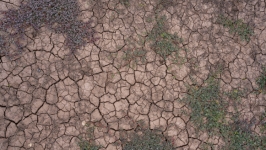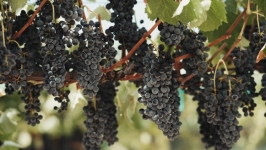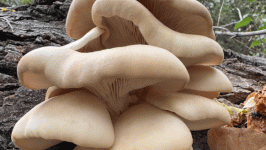How to Regenerate a Desert
Even in the waning days of December, the sun beats down strongly on Oatman Flats Ranch. Dax Hansen, who purchased the property in 2019 with his wife, Leslie, wears his grandfather’s cowboy hat with the brims shaped high by a milliner into an exaggerated taco—his grandfather’s preferred style.
Soon after I arrived, Hansen offered me a hat to borrow while we toured the fields, which I naively declined. The intensity of the winter sunlight—even at 8am—was deceiving in the brisk morning air.
His team was in the finishing stages of converting their flood irrigation to a drip system. When he purchased the ranch, the soil was reluctant to absorb and hold water. The irrigation would wash over the earth and slowly soak in over the course of days, further contributing to the desertification, erosion and degradation of the land.
Six years later, the flood irrigation, pumped from siphon tubes on the field’s borders, doesn’t have time to stretch across the entire acreage before it is absorbed in the perimeters. The ground, now rich in organic matter, takes in and retains water more efficiently. The drip system is better suited for the healthier soil.
Under construction was a large settling pond that will store water from an underground aquifer before it is pushed further into the drip system. Joe Turner, of Laurel Ag and Water, who helped design the system, has farmed in Arizona for decades and was overseeing construction of the pond.
“I installed my first drip irrigation system in 1980,” Turner said. “I had to go to Israel to get the technology 44 years ago.”
Turner walked back to his truck and returned with a baseball cap branded with his company logo, which he offered me. The sun was quickly becoming more intense and I didn’t dare to make the same mistake again.
Having first visited Oatman Flats Ranch in the 1970s, Turner recounted how the area has changed over half a century. He said back then it was primarily planted to cotton.
Hansen nodded. It was his grandfather’s ranch at that time, his grandfather’s cotton. He listened to Turner and observed the scene as heavy machinery roared nearby.
“We’ve got the best of just old school farming knowledge out here,” Hansen said, “plus the cutting edge of environmental science to figure out regenerative agriculture in this brittle desert environment.”
The Junction of History
Dax Hansen’s family has been in Arizona for five generations. His grandfather raised quarter horses for racing, farmed in the Mesa-Phoenix area and was one of the state’s early cotton farmers. His grandparents, parents, aunts and uncles were big into the rodeo.
“Arizona’s in our roots,” he said. “I come from farming and ranching roots.”
In the 1950s, his grandfather purchased Oatman Flats Ranch, an over-600-acre homestead property outside Gila Bend, where he ran cattle and farmed cotton. Hansen grew up driving the tractor, searching for “‘treasure’” with a metal detector and walking the historic trails under the expansive skies.
Hansen’s dad found farming was hard work with little economic opportunity and transitioned into construction, then encouraged his children to focus their studies on subjects such as law or medicine. For Hansen, now a technology lawyer, splitting his time between Arizona and Seattle, the land had touched his soul.
“It was a place that shaped me, for sure, but it was formative for all [my family]. What was riveted into my soul was how significant this land was from a historical and a cultural perspective. It’s like holy ground.”
Straddling the Lower Gila River, the ranch is surrounded by low-lying mesas that frame the vista into a shallow, rectangular canyon. Black basalt rocks formed by a primordial volcano range lend a striking appearance to the mountains.
The region contains several important archeological sites. Numerous present-day tribes in Arizona descend from peoples who farmed for millennia along the Gila River. Thousands of petroglyphs are carved into the basalt rocks—one of the largest concentrations of its kind in the country. Over time, the petroglyphs have been amended with more modern inscriptions. Ancient symbols coincide with dates from the 1800s and later.
The ranch, named for the Oatman Massacre of 1851, is a living museum. Due to its location as a floodplain along the river, it has served as a corridor and provided respite for missionaries and expeditionists like Juan Bautista de Anza, who traveled through the area in the late 1700s.
The Mexican-American War, California Gold Rush and commercial stagecoach routes all brought settlers and travelers through the ranch. William Fourr, an early settler who worked as a station keeper for the Butterfield stage line depot, had six children with his wife, Lucinda, while living there in the 1870s. Gravestones marking three of their children’s burials still stand under the shade of a large mesquite tree adjacent to the ranch’s southern field.
In 2018, Hansen learned his family had decided to sell the ranch. He was compelled to preserve its unique history and saw an opportunity to help usher in a new chapter in Arizona’s agricultural history. He purchased the property, knowing it would not be easy.
“Climate change hit hotter and drier everywhere. Even the salt cedar and mesquite trees out there are dying. The river’s not flowing anymore. We became the epicenter of desertification for the whole country, frankly. And Oatman Flats Ranch is right there in the middle of [it all].”
Finding Heritage
Hansen knew he wasn’t going to grow water-intensive crops like cotton or alfalfa; he wanted to focus on better climate-adapted crops for the arid environment. He studied the ethnobotany of the land to understand its relationship with the people who lived there before him. What had they grown there? How could he learn from it?
The Mission Garden in Tucson, where agriculture has been practiced for over 3,500 years by the Hohokam and Tohono O’odham, helped answer those questions. The garden is described as a living agricultural museum, containing native, traditional and heirloom species like quince and white pomegranate.
Hansen credits Juan Garcia and Dina Cowan, who are affiliated with the museum, for promoting the agricultural heritage of the region. These two “desert whisperers,” as Hansen called them, are also involved in the Kino Heritage Tree Project, which identifies and propagates fruit tree cultivars introduced in the 17th and 18th centuries by Jesuit and Franciscan missionaries.
Inspired by the Mission Garden, Oatman Flats Ranch started its own test garden and planted Spanish colonial fruits, prickly pear and agave to see which varieties would best adapt to the arid temperatures and the area’s water salinity. Those surviving plants are cultivated and expanded on the property.
“Let’s capture what used to be [here],” he explained his intention, “and then let’s think about climate change and what we’re going to be able to farm with increasingly less water and the hotter, drier conditions that we have.”
Around the same time, Hansen attended a conference at University of Arizona where he learned about heritage grains grown prior to scientific plant breeding of the 20th century. One of the speakers at the conference was Bob Quinn, a farmer and founder of KAMUT International. Quinn helped revitalize a grain called Khorasan, or “King Tut,” which traces its origins to Egypt.
The grain was introduced in Montana in the 1950s. Quinn was 16 years old when he received samples of it at a county fair. It was not commercially embraced and eventually faded into obscurity before Quinn promoted the grain under the trademark KAMUT in the 1990s. Its popularity has since grown.
Arizona has its own variety of heritage wheat. Native Seeds/SEARCH is a Tucson-based seed bank dedicated to preserving and distributing seed varieties in the U.S. Southwest and Mexico for more than four decades. One of the heritage varieties they’ve revitalized is White Sonoran Wheat, introduced via Spanish missions in the 17th century.
“The food that I want to produce,” Hansen said, “is all about [finding] a way to grow something that is viable for our region, that helps us retain the cultural legacy, historical legacy of the land and the people who used to live [here].
Oatman Farms, the food company born of the ranch, now produces a line of packaged goods made from White Sonoran Wheat along with other heritage grain varieties, such as Red Fife (descended from Eastern Europe and widely used in Canada before the Great Depression) and Blue Beard Durum, which originated in the Fertile Crescent. These grains are naturally more drought tolerant and nutrient dense when farmed and milled accordingly.
For every pound of White Sonoran Wheat grown, 700 gallons of water are conserved, compared to growing cotton or alfalfa. By growing these heritage grains, Oatman Farms estimates it has conserved over a billion gallons in the Gila River aquifer, which supplies water to over half a dozen communities, wildlife refuges, agricultural operations and residential properties.
Hansen believes these varieties and the work done by people like Garcia and Cowen for the Mission Garden and Kino Heritage Tree Project are examples of how to farm in the desert in the age of climate change. And regenerative agriculture, he added, “is the vehicle through which I think we can successfully grow these crops and regenerate the landscape.”
Regenerating the Desert
The term regenerative agriculture was popularized by the Rodale Institute in the 1980s. Kevin Morse, co-founder of Cairnspring Mills of Northwest Washington’s Skagit Valley, introduced Hansen to the idea.
When he learned that Cairnspring Mills was becoming Regenerative Organic Certified, Hansen was immediately curious. The certification is a farming standard created by the Regenerative Organic Alliance and, according to Hansen, is the gold standard for regenerative agriculture.
“Regenerative agriculture,” Hansen describes, “is agriculture that utilizes practices that fix the broken cycles and systems of the earth. We farm in a way that intentionally makes things better rather than just being chemical free.”
However, a precise or formal definition is still up for debate, in part due to the novelty of the concept. Regenerative agriculture overlaps and builds upon other methods of farming that prioritize environmental health, such as organic, biodynamic and sustainable farming.
“Part of the reason [regenerative farming is] not well known is that it’s not widely defined yet. There’s not a consensus even amongst the farmers and the gardening community,” Hansen said.
A few key practices are no-tillage farming, cover cropping and promoting plant and animal biodiversity. Hansen recommends visiting regenorganic.org for more technical standards employed by the Regenerative Organic Alliance.
According to Hansen, Oatman Flats Ranch became the first Regenerative Organic Certified farm in the Southwest.
The Scientist
Out in the ranch’s north field, Farm Manager Yadi Wang thrusted a penetrometer—a large probe used for measuring soil compaction—deep into the ground. A meter on top of the probe migrated to the red, signaling the ground was compacted, before quickly dropping back down. He said that is exactly what he looks for.
In 2021, when Wang joined the team, the dial on the penetrometer swung into the red and remained there. The ground was too compacted, requiring tilling the soil, disturbing its microbial ecosystem and contributing to loss of moisture.
Now, when inserted into the ground, the penetrometer measures the consolidated structure in the topsoil created by systems of mycorrhizal fungi and organic matter. The dial then drops back down once it hits the loose, aerated soil underneath.
He shoves another instrument into the soil to retrieve a core sample from more than a foot below the surface. Upon releasing, the core sample shows a dark, rich color that is damp with moisture. This particular field has not been irrigated since March, consistently retaining moisture in an area that averages around seven inches of rainfall per year.
Wang grew up in the port city of Tianjin in Northern China, immigrating to the U.S. in 2010 to pursue college basketball and later becoming a chemical process engineer. He became disillusioned working on projects in the mining industry, where he witnessed the catastrophic environmental damage caused by mine tailings and the public health consequences from dust particles and heavy metals leaching into groundwater.
He decided to pursue a PhD studying soil science and hydrology at University of Arizona, eventually becoming part of the team that worked on Biosphere 2.
“I was supposed to be trained to be a specialist,” Wang said. “ . . . one of the top scientists in controlled environments.”
The more specialized Wang became in his education, however, the more disconnected he felt the approach was from natural systems.
“Why do we want to isolate variables and try to study [an] individual thing?” he asked. “That doesn’t make sense in nature. In nature, everything is being combined together.”
His father-in-law, a sixth-generation farmer in Indiana, had a profound influence on Wang. He was the first to teach him about farming when Wang lived there for a year and a half and instilled in him three important values: family, community and land.
When his father-in-law passed away, Wang decided to become a farmer, almost moving back to Indiana with his wife and baby daughter. Then a colleague shared the job posting for a farm manager position at Oatman Flats Ranch. After calling Hansen, Wang went to see the ranch in person and learned more about Hansen’s vision. He had never heard of regenerative farming, but it resonated with him.
Wang began to draw on his own personal history for inspiration. China’s agricultural history, spanning over 10,000 years, is one of the oldest in the world. Continuous farming over millennia and generations for that length of time, he says, is only possible by doing so in a way that respects the health of both the land and its people.
“I used to call myself a first-generation farmer because I didn’t see a farm until 2015, but I never recognized that [it’s] in my bones. My last name, Wang, is one of the eight largest families in Chinese history.”
The chemical engineer turned soil and water scientist found a way to utilize his specialized knowledge in a more holistic approach.
Productive Partnerships
On the morning I visited Oatman Flats Ranch, Wang was bent over a small stone mill he was closely watching. They had received two orders that morning, which he was promptly filling. They mill the flour to order, ensuring it’s received in fresh condition, since the nutritional value of flour degrades over time through oxidation.
Oatman Farms has released several products and has others in development. Stone-milled flour, wheat berries, pancake mix and vanilla extract are available for purchase on their website, which also details which flour is best suited for a particular purpose. Red Fife flour, for example, is listed as containing a naturally higher gluten content, making it ideal for pasta.
They have forged several partnerships throughout the state including Pizzeria Bianco and Chompie’s, which serves classic Jewish deli fare using Oatman Farms’ regenerative grown wheat to make bagels, dinner rolls and soft pretzels.
Arizona Wilderness Brewery, which Hansen described as mission-aligned in saving Arizona’s natural resources, features Oatman Farms products in sandwiches, desserts and beer made from malted White Sonoran Wheat.
Through these partnerships, Oatman Farms heals the land by bringing regenerative food into our kitchens and communities. The key to regenerative agriculture, Hansen stressed, is that it takes a community.










